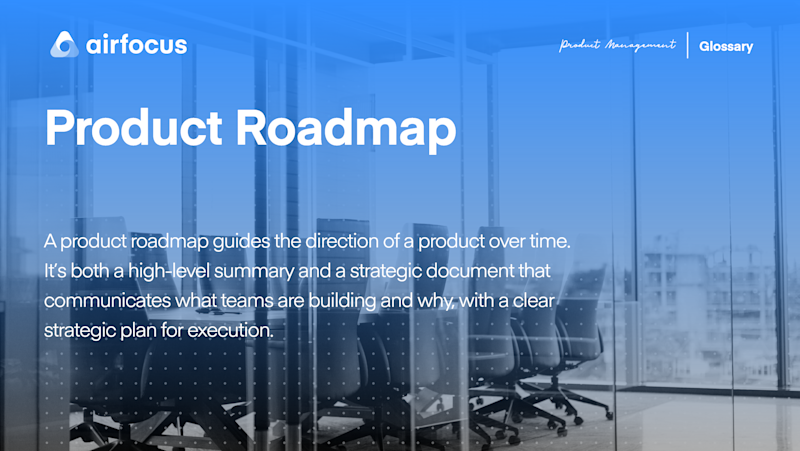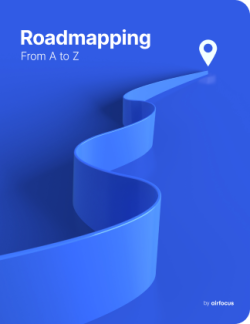Product Roadmap
What is a Product Roadmap
Definition of a Product Roadmap
A product roadmap guides the direction of a product over time. It’s both a high-level summary and a strategic document that communicates what teams are building and why, with a clear strategic plan for execution.
Broadly speaking, a product roadmap serves several purposes:
It maps out your vision and strategic goals, presented in a visual way
Details how you’ll deliver against that vision and strategy
Communicates the necessary information to align stakeholders
Sets your priorities so that you focus on what’s important.
What is included in a product roadmap?
The content of your product roadmaps will differ one from another, depending on who the audience is.
However, there are some important core components that will apply most of the time:
Milestones
Items
Initiatives
Responsible people or teams
Themes
Timings
Progress
How do I create a product roadmap?
With airfocus, creating a product roadmap is a simple task. Here is what you have to do:
Define your product strategy.
Review initiatives and ideas.
Define requirements and features.
Organize features and stages of functionality into product releases.
Choose one of the airfocus templates that suit your product best.
Add your features, projects, initiatives, and ideas manually, or you can import these from any tool you used previously.
Prioritize which roadmap comes first and map all your priorities using a chart to understand the next steps.
Start sharing your roadmap through a simple link to align all team members to the company’s strategy.
Don’t forget that roadmaps constantly change, so it is important to keep everyone in the loop.
Check our our product roadmap template to get a better idea.
What are the main objectives of a product roadmap?
A roadmap helps you to see how you intend to accomplish your goals. Roadmaps must indicate the end goal and how you will get there.
The rest of a product roadmap’s main objectives can be summarized using the ROADMAPS acronym. Each letter stands for:
Route: A roadmap shows how exactly we’ll reach our desired outcomes. Generally speaking, you can achieve a goal in many ways, but we can explain in detail why we chose a specific route using a roadmap.
Outcomes: The product roadmap is our connection between the present and the future. In other words, where we are currently situated as a company versus what outcomes we wish to achieve.
Alignment: A roadmap explains the destination and the path to the whole team, so everyone pulls towards the same goal. Newcomers can immediately grasp the objectives and the plan for achieving them.
Development: Another neat roadmap objective is tracking the development made in a certain amount of time. This way, product managers can constantly check if everything is going according to schedule.
Management: Product managers may plan ahead by determining the resources they will require, verifying that all tasks reliant on one another have been finished, and scheduling the appropriate team meetings and tasks.
Accountability: A roadmap can serve as a guide for who will deliver what and when holding team members accountable.
Prioritization: Roadmaps can reveal intricate dependencies, obstructions, and restrictions. Product managers can address these possible issues in advance by developing a plan.
Sharing: A roadmap makes it easier to communicate with coworkers and stakeholders. People can monitor progress and assist teams in achieving their objectives by sharing the roadmap.
The benefits of product roadmaps
A product roadmap maps out the vision and strategic objectives for a product in a visual way, making it easier for development teams to share and collaborate. It displays priorities and details how everyone will deliver against the vision and strategy.
A roadmap also makes it easier for other product stakeholders to understand the most up-to-date status, how features are being prioritized, the long-term direction of travel, and the plan for execution.
By helping everyone involved understand how their input fits into the bigger picture, a product roadmap helps keep teams aligned, on-track, and focused on the right things.
Examples of product roadmaps
Product roadmaps are typically used in software development, but their core benefits — easier collaboration, better progress tracking, and visualization of the product strategy — can be useful in almost any business setting.
There are three main types of product roadmap:
Progress-based roadmaps:
A progress-based product roadmap divides actions into lanes (usually columns on a Kanban board) defined by progress achieved, for example complete, in progress, and to-do.
Progress-based roadmaps are often used in agile development as they aren’t restricted by dates and timelines.
Generally speaking, they offer teams more flexibility as tasks are tracked based on progress rather than strict deadlines.
Time-based roadmaps:
Time-based roadmaps can be an excellent method for visualizing how a product has progressed — and will advance further — over time. Time-based roadmaps divide tasks according to dates, milestones and deadlines.
Mixed roadmaps
Some companies will opt for a roadmap that mixes elements from progress- and time-based roadmaps.
For example, they might use the lanes in a progress-based roadmap to divide tasks by their rough timescale for completion: in-progress, next-up, coming soon, or even ‘maybe’.
When do you need a product roadmap?
Creating a new product or managing its lifecycle is a complex endeavor requiring multiple skill sets, careful allocation of time and resources, and alignment between technical and non-technical stakeholders.
As the digital economy shifts and grows, the business and competitive landscape can change quickly. In such a dynamic environment, product development teams need product roadmaps to:
Align key stakeholders with competing needs
Make objective prioritization decisions
Develop a product against an overarching business strategy.
Selecting features and setting a cadence of updates requires both careful planning and prioritization. This process becomes much simpler with a product roadmap. Roadmaps keep features in the pipeline without necessarily committing them to any specific release. That flexibility makes it easier to prioritize and still make course corrections as conditions change, or new information arises.
What are product roadmaps used for?
A product roadmap ties the day-to-day work of product teams to the company’s vision for both the product and the wider business.
In general terms, product roadmaps are used to:
Capture a product’s development strategy in a format that is easy to comprehend and share
Establish a single source of truth for everyone executing the strategy
Simplify collaboration and team planning
Visualizing product vision and strategy in a roadmap can also make it easier to keep team members working toward a common goal, while securing executive buy-in for the development approach.
History of product roadmaps
Product roadmaps have been around in one form or another since the dawn of personal computing in the 1980s.
Beginning with technology roadmaps, the concept was refined by Cambridge University with its T-Plan in the late 1990s, designed to address slow-downs and inertia in development processes.
The rise of Agile Development led to further refinements and the creation of a specific approach to product roadmaps.
What are some common challenges in creating product roadmaps?
Deciding which features or upgrades make it onto a product roadmap requires careful prioritization.
Product managers have to derive as much productivity as they can from limited resources and allocate them to tasks with the biggest impact.
Using a quantitative and time-efficient framework, such as a prioritization matrix or weighted scoring model, can help ensure that roadmaps are focused on the most urgent and strategic tasks.
What are some pros and cons of product roadmaps?
Pros
Product roadmaps facilitate planning in a dynamic, fast-changing business.
They help product teams stay focused on the features deemed most valuable by the business.
Stakeholders gain a visual tool to see how a product is progressing and understand quickly how changes to the priority of one feature can impact other planned features and updates.
Product roadmaps help product managers fight scope creep. When multiple teams are working together, the roadmap keeps them focused on priority or high-value outcomes.
Cons
Roadmaps can cause problems if they are based on old or inaccurate data; or false assumptions about the achievability of timescales.
Time-based roadmaps can sometimes be too restrictive in a dynamic business environment that requires a more flexible roadmap.
Mixed roadmaps can offer teams more flexibility, but their lack of commitment to firm timescales and priorities can create issues related to vagueness, and open the door to scope creep.
Poor prioritization in roadmaps can also cause issues, particularly in resource allocation.

General FAQ

Glossary categories
Build great roadmaps

Experience the new way of doing product management








